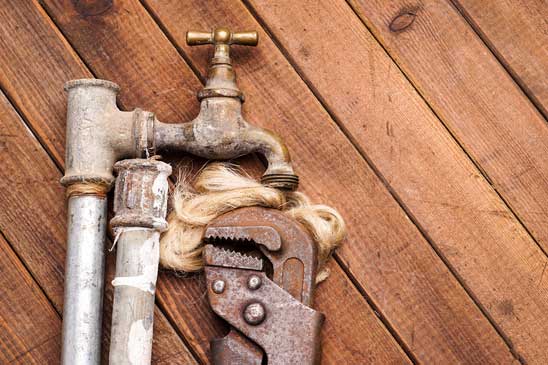Without question, there is an intrigue that goes along with old homes. They have character and charm typically not found in newer homes. While older homes offer benefits, there are also a few drawbacks, one being the plumbing.
Galvanized Piping
Prior to the 1960s, most homes were built with galvanized steel piping. Because this was so popular at the time, when buying a home from that era or earlier, there is a good chance that some if not all of the plumbing has already been repaired or replaced.
However, before buying an older home, it is important to understand that unchanged plumbing could be a real concern. One method of testing pipes is to hire a plumber as part of the home inspection. However, there are ways that you can check to see if pipes are galvanized steel.
The first involves turning on the hot water. If water pressure is low, more than likely the pipes are galvanized. The reason is that as these pipes age, they become clogged and/or corroded. When that happens, pipes for hot water are always the first to start shutting down.
Of course, even if there is good water pressure, there could still be hidden problems. Again, many older homes have had new piping installed (but likely not all of it), so any galvanized pipes remaining will at some point begin to cause issues, which equates to a big expense. There is also the risk that more galvanized pipes were used to replace the bad galvanized pipes as opposed to more modern options of plastic or copper.
The challenge is that piping is behind walls, so trying to determine the type can be tough. One option involves looking under bathroom and kitchen sinks. Sometimes new pipes are installed to run through the flooring beneath sinks as opposed to through walls, so if new piping is visible, some or all of the galvanized pipes were replaced. Another possibility is to check inside the crawlspace, if one exists.
It is important to remember that whenever copper pipes are added to galvanized pipes, the only way to stop the process of corrosion is with dielectric coupling. Sometimes, this type of coupling is visible, but in older homes, it is usually behind the walls as well.
Sewer Line
Another problem commonly found in older homes is not a problem with the sewer line at the street. If a problem develops where the meter is, the responsibility falls back on the homeowner, whereas anything else is the responsibility of the water district. There is a dial on the meter that indicates water flow per minute. If the main water valve to the home is shut off but the dial continues to move, a leak is somewhere else.
For an older home that is on a sewer line, piping goes from the home to the street, so if there is something wrong at the street level, usually caused by tree roots or even a collapsed line, it turns into a lengthy mess. To determine if the sewer line is the problem, the city should investigate, but you can always hire a plumber to run a camera down the line for around $250.
Sewer lines can be made from a variety of materials, including plastic, cast iron, and clay. However, in homes built during the WWII era, chances are good the lines are constructed from tarpaper. Lines made of plastic became popular in the 1980s. This material is strong and durable, so there is no risk of collapse, but they can still become clogged or root bound.
Possible Solutions
The best thing is to know upfront what type of pipes and sewer line exist for anyone interested in purchasing a new home. From there, the decision can be made to buy or to choose a different property. If you want to purchase an older home, you should expect that at some point, new piping will be required. Although the cost to replace all supply lines will differ from one geographical area and plumber to another, on average this job will run about $2,000.
If you have a somewhat limited budget, it is possible to replace a portion of the galvanized pipes at a time, knowing that eventually they will all need to be changed out. Obviously, this is a big job and one best left to a licensed plumber who has the expertise required.
There will always be surprises when buying older homes, which is simply the nature of the beast. While many surprises are exciting, some can be a big and expensive problem, as is the case with galvanized pipes and outdated sewer lines.




